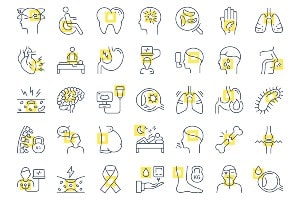About Supravalvar Aortic Stenosis Syndrome (Williams Syndrome)

Learn about the disease, illness and/or condition Supravalvar Aortic Stenosis Syndrome (Williams Syndrome) including: symptoms, causes, treatments, contraindications and conditions at ClusterMed.info.
Supravalvar Aortic Stenosis Syndrome (Williams Syndrome)

| Supravalvar Aortic Stenosis Syndrome (Williams Syndrome) |
|---|
Supravalvar Aortic Stenosis Syndrome (Williams Syndrome) InformationWilliams syndrome definition and facts**Williams syndrome definition and facts medical author: Charles Patrick Davis, MD, PhD
How common is Williams syndrome?Williams syndrome affects an estimated 1 in 7,500 to 10,000 people. Is Williams syndrome inherited?Most cases of Williams syndrome are not inherited, but occur as random events during the formation of reproductive cells (eggs or sperm) in a parent of an affected individual. These cases occur in people with no history of the disorder in their family. Williams syndrome is considered an autosomal dominant condition because one copy of the altered chromosome 7 in each cell is sufficient to cause the disorder. In a small percentage of cases, people with Williams syndrome inherit the chromosomal deletion from a parent with the condition. What are the signs and symptoms of Williams syndrome?People with Williams syndrome typically have difficulty with visual-spatial tasks such as drawing and assembling puzzles, but they tend to do well on tasks that involve spoken language, music, and learning by repetition (rote memorization). Affected individuals have outgoing, engaging personalities and tend to take an extreme interest in other people. Attention deficit disorder (ADD), problems with anxiety, and phobias are common among people with this disorder. Young children with Williams syndrome have distinctive facial features including
What genetic and chromosomal changes are related to Williams syndrome?Williams syndrome is caused by the deletion of genetic material from a specific region of chromosome 7. The deleted region includes 26 to 28 genes, and researchers believe that a loss of several of these genes probably contributes to the characteristic features of this disorder. CLIP2, ELN, GTF2I, GTF2IRD1, and LIMK1 are among the genes that are typically deleted in people with Williams syndrome. Researchers have found that loss of the ELN gene is associated with the connective tissue abnormalities and cardiovascular disease (specifically supravalvular aortic stenosis) found in many people with this disease. Studies suggest that deletion of CLIP2, GTF2I, GTF2IRD1, LIMK1, and perhaps other genes may help explain the characteristic difficulties with visual-spatial tasks, unique behavioral characteristics, and other cognitive difficulties seen in people with Williams syndrome. Loss of the GTF2IRD1 gene may also contribute to the distinctive facial features often associated with this condition. Researchers believe that the presence or absence of the NCF1 gene on chromosome 7 is related to the risk of developing hypertension in people with Williams syndrome. When the NCF1 gene is included in the part of the chromosome that is deleted, affected individuals are less likely to develop hypertension. Therefore, the loss of this gene appears to be a protective factor. People with Williams syndrome whose NCF1 gene is not deleted have a higher risk of developing hypertension. The relationship between other genes in the deleted region of chromosome 7 and the signs and symptoms of Williams syndrome is under investigation or unknown. What is Williams syndrome?Williams syndrome is a developmental disorder that affects many parts of the body. This condition is characterized by mild to moderate intellectual disability or learning problems, unique personality characteristics, distinctive facial features, and heart and blood vessel (cardiovascular) problems. What other names do people use for Williams syndrome?
|
More Diseases
A | B | C | D | E | F | G | H | I | J | K | L | M | N | O | P | Q | R | S | T | U | V | W | X | Y | Z
Diseases & Illnesses Definitions Of The Day
- Noncancerous Colloid Thyroid Nodule (Thyroid Nodules) ‐ How are thyroid nodules diagnosed?, Introduction to thyroid nodules …
- Skin, Laser Resurfacing (Laser Resurfacing) ‐ CO2 Laser Resurfacing, Complications of Laser Skin Resurfacing …
- Malignant Fibrous Histiocytoma (Bone Cancer Overview) ‐ Are there any treatments or medications that relieve bone cancer pain? …
- Double Vision ‐ Is it possible to prevent double vision?, What are the symptoms and signs of double vision? …
- Ageusia (Taste Disorders) ‐ Are taste disorders serious?, Can taste disorders be treated? …
- Autism Screening and Diagnosis ‐
- Alpha-fetoprotein Blood Test ‐ In which situations are high blood (serum) levels of AFP used as a tumor marker? …
- Polymyalgia Rheumatica ‐ How do health care professionals make a diagnosis of polymyalgia rheumatica? …
- Stump Appendicitis (Appendicitis) ‐ Appendicitis definition and facts, Are there long-term consequences of appendectomy? …
- Gonorrhea (Gonorrhea In Women) ‐ Gonorrhea facts, How is gonorrhea diagnosed?, What are sexually transmitted diseases (STDs)? …